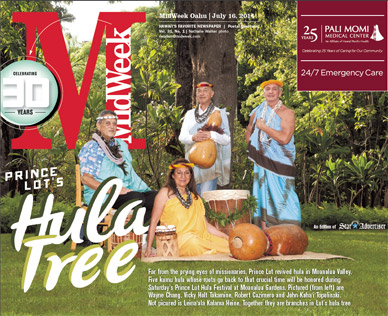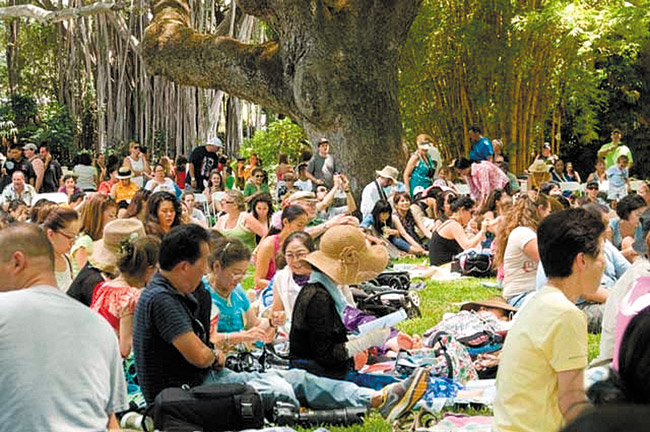Prince Lot’s Hula Tree
Far from the prying eyes of missionaries, Prince Lot revived hula in Moanalua Valley. Five kumu hula whose roots go back to that crucial time will be honored at Saturday’s Prince Lot Hula Festival at Moanalua Gardens
Hawaii’s history is rich with mo’olelo, or stories, and since I’ll be sharing some history with you, let me tell you a story. Once upon a time the beautiful dancing movements of a proud people came to a halt. Voices that rang out, receptacles of history, from the kumulipo, or creation chant, to ancestral chants, celebration chants, mourning chants and, yes, mele ma’i, or chants of procreation, were silenced. Partially clad bodies swaying scandalously, celebrating reproduction of all things, was simply too much for early missionary sensibilities. Hula — which was never just a dance, but the living cultural soul of a people — was banned throughout the land. No longer were the ladies searching the forest, ritualistically chanting as they collected leaves, vines and berries that they would fashion into lei and garments. No longer were pahu, or drums, and ipu, or gourds, being fashioned and played. No longer was musical knowledge passed from kumu, or teacher, to haumana, or student, the one initiating the other into a way of life.
The good news is there’s always one person who questions the status quo, and in this case the royal rebel was Prince Lot, Kamehameha V. He made use of his summer cottage at the enchanting stretch of grasses, monkey pod shade and streams of Kamananui Valley, in an area we know now as Moanalua Gardens, to host secret celebrations of hula, keeping the tradition alive. Hence Moanalua Gardens Foundation’s annual Prince Lot Hula Festival, happening this year July 19, and themed “Kila Kila O Moanalua … Majestic is Moanalua.”
Honoring Living Hula Legends
If Prince Lot is responsible for a renaissance of sorts, a later generation comprised of hula masters such as Malia Kau and Maiki Aiu could be said to have ushered in a second renaissance that has bestowed upon us legendary kumu hula of our time, including Robert Cazimero, Leina’ala Kalama Heine, Vicky Holt Takamine, Kaha’i Topolinski and Wayne Chang. These five luminaries, who have worked lovingly and laboriously to perpetuate the invaluable cultural elements of hula, are being honored with MFG’s first ever Malia Kau Award.
To understand the significance of this award one should know a little of Malia Kau’s background. Born in 1881, nine years after Lot’s passing, she descended from Moanalua Valley’s earliest inhabitants and was surrounded by hula masters who mentored her. She, in turn, remained in Moanalua and passed on her sacred knowledge. Among the list of modern hula masters who studied with Malia Kau is Maiki Aiu, kumu to these first five honorees of the Malia Kau award.
“We wanted to honor these five kumu hula because they are the heart of the Prince Lot Hula Festival,” says MGF managing director Pauline Worsham. “We decided to create the Malia Kau Award because of the connection to Kamananui Valley. Malia Kau passed down the hula and chants of Moanalua to the teachers (of the honorees).
Those being honored are now kupuna themselves, and they are honoring their kumu hula by passing on their tradition to their haumana. All five have a tie to the Prince Lot Hula Festival from the very beginning.”
1980: Dedicating the Pa
While the Prince Lot Festival was founded in 1978, a festival landmark was the 1980 dedication of Moanalua Gardens’ pa hula, or hula mound, in honor of Prince Lot’s ipo, or sweetheart, from Molokai. The pa is one of the last few remaining in Hawaii.
Wearing the original lei and kihei, or robe, his kumu gave him in the colors of earth, sky and ocean, representing life, Kumu Kaha’i Topolinski recalls presiding over the ceremony of the pa with its newly planted grass and encircled in a 400-foot lei. His voice falters and his eyes moisten as he recalls the significance of that day, performing with his halau in tribute to Auntie Maiki and his various other hula mentors.
“Our dancers came out and we walked on the mound and it was just like the old days,” he says. “We were put back hundreds of years.
“It was Kumu Maiki,” he adds, “who brought back the idea of graduating kumu so we can carry on to the next generation.”
These days when titles can be acquired readily, Topolinski, who also is an expert feather worker, points out that his kumu initiated her students in the ancient way, with years of rigorous training that culminated in an intensive ‘uniki ritual, or rite of passage ceremony.
As a member of the Royal Order of King Kamehameha I, which was founded by Prince Lot in honor of his grandfather, Kamehameha the Great, Topolinski will participate in the opening royal procession, and his halau Ka Pa Hula Hawaii will once again bring back a number they performed in 1980.
“I have a small halau,” he says, “but they can hold that stage. They will be doing a dance to Kamehameha V, a hula kake, which means the words are jumbled to hide his voyages to Molokai to see his girlfriend. The Ks became Gs, so only the people who knew understood what was going on.”
Non-competitive Hula, Simply for the Joy of It
Fellow kumu Wayne Chang, whose delicate health keeps him from being as active as he once was, nevertheless contemplates his Moanalua Gardens surroundings with a robust voice:
“(Moanalua Valley) was a wonderful place for Prince Lot to bring hula out in the open, because missionary eyes were not here. He always asked the different kumu to bring their dancers, and they would have these wonderful shows, this ho’ike for Prince Lot. For those of us in hula, it’s an amazing thing to see this place where our historical roots were regenerated. Kalakaua brought it even more public, but Prince Lot is the one who really saved it because it was dying.”







